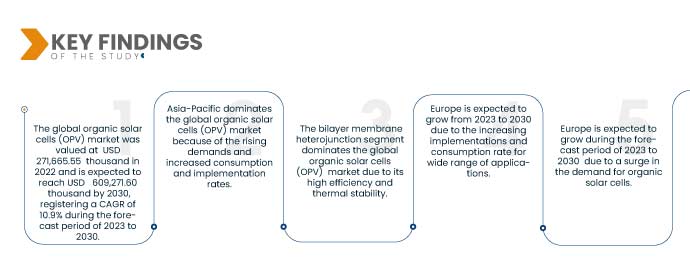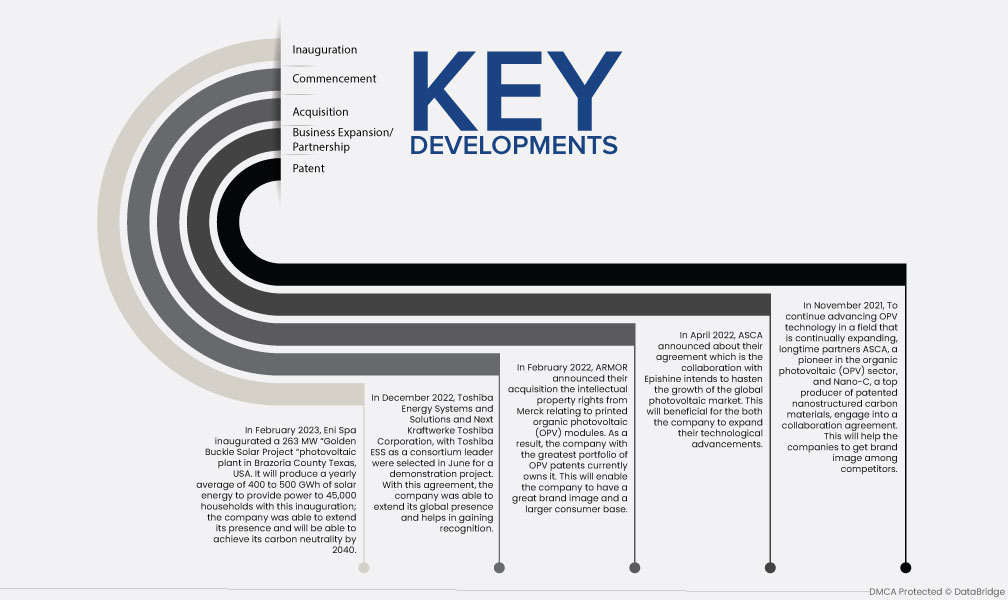С ростом доходов и развитием технологий в сочетании с растущим вниманием к сохранению окружающей среды, в мегаполисах растет число пользователей солнечных батарей для жилых целей. Растущая государственная поддержка и многочисленные схемы налоговых льгот привели к увеличению использования солнечных систем для жилых применений.
Доступ к полному отчету по адресу https://www.databridgemarketresearch.com/reports/global-organic-solar-cell-opv-market
Data Bridge Market Research анализирует, что ожидается, что глобальный рынок органических солнечных элементов (OPV) будет расти в среднем на 10,9% в прогнозируемый период с 2023 по 2030 год и, как ожидается, достигнет 609 271,60 тыс. долларов США к 2030 году. С ростом доходов и развитием технологий в сочетании с растущим вниманием к сохранению окружающей среды увеличивается число пользователей солнечных батарей в мегаполисах для жилых целей. Растущая государственная поддержка и многочисленные схемы налоговых льгот привели к увеличению использования солнечных систем для жилых помещений.
Основные выводы исследования
Рост спроса на интегрированные фотоэлектрические продукты (BIPV)
Органические фотоэлектрические элементы являются тонкими и гибкими и могут быть встроены в боковые стороны зданий, заменяя обычные стеклянные окна. Это обеспечивает большую доступную площадь для поглощения солнечной энергии. Световые люки OPC интегрируются с использованием ультратонких органических солнечных элементов, которые позволяют проникать дневному свету, одновременно вырабатывая электроэнергию .
Интегрированные в здания фотоэлектрические элементы (BIPV) относятся к материалам, которые используются для оболочки здания, заменяя обычные строительные материалы на крышах , световых люках и фасадах, среди прочего. С BIPV здания имеют внешний слой структуры, который также генерирует электроэнергию для использования на месте или экспорта в сеть. Приложения BIPV часто применяются для коммерческих и промышленных зданий. Использование OPV имеет значительные преимущества по сравнению с кремниевыми солнечными элементами, поскольку они приводят к снижению затрат. Они легкие, гибкие и визуально прозрачные. Это привело к росту использования органических фотоэлектрических элементов в качестве материала в приложениях BIPV.
Область отчета и сегментация рынка
Отчет Метрика
|
Подробности
|
Прогнозируемый период
|
2023-2030
|
Базовый год
|
2022
|
Исторические годы
|
2021 (Можно настроить на 2020 - 2015)
|
Количественные единицы
|
Доход в тыс. долл. США
|
Охваченные сегменты
|
По типу (двухслойная мембрана, гетеропереход, тип Шоттки и другие), материалу (полимеры и малые молекулы), применению (BIPV и архитектура, бытовая электроника, носимые устройства, автомобилестроение, военная промышленность и устройства и другие), физическому размеру (более 140*100 мм в квадрате и менее 140*100 мм в квадрате), конечному пользователю (коммерческие, промышленные, жилые и другие).
|
Страны, охваченные
|
США, Канада, Мексика, Германия, Франция, Великобритания, Италия, Россия, Испания, Нидерланды, Бельгия, Швейцария, Турция и остальные страны Европы. Япония, Китай, Южная Корея, Индия, Сингапур, Таиланд, Индонезия, Малайзия, Филиппины, Австралия и остальные страны Азиатско-Тихоокеанского региона, Бразилия, Аргентина и остальные страны Южной Америки, Южная Африка, Египет, Саудовская Аравия, ОАЭ, Израиль и остальные страны Ближнего Востока и Африки.
|
Охваченные участники рынка
|
Eni SpA (Рим и Италия), TOSHIBA CORPORATION (Токио и Япония), ARMOR - Siège social (Нант и Франция), Tokyo Chemicals Industry UK Ltd (Токио), Merck KGaA (Германия), Alfa Aesar, Thermo Fisher Scientific (Великобритания), Heliatek (Франция), Solarmer Energy Inc. (США), SUNEW (Бразилия), Epishine (Швеция), Lumtec (Тайвань), Borun New Material Technology Co., Ltd, (Китай), Novaled Gmb (Германия), Ningbo Polycrown Solar Tech Co, Ltd, (Китай), SHIFENG TECHNOLOGY CO., LTD., (Тайвань), Solaris Chem Inc., (Канада), MORESCO Corporation (Япония), NanoFlex Power Corporation (США) и Flask (Сингапур) и другие.
|
Данные, отраженные в отчете
|
Помимо аналитических данных о рыночных сценариях, таких как рыночная стоимость, темпы роста, сегментация, географический охват и основные игроки, рыночные отчеты, подготовленные Data Bridge Market Research, также включают в себя углубленный экспертный анализ, эпидемиологию пациентов, анализ воронки продаж, анализ ценообразования и нормативную базу.
|
Анализ сегмента:
Мировой рынок органических солнечных элементов (OPV) сегментирован по типу, материалу, применению, физическому размеру и конечному пользователю.
- На основе типа глобальный рынок органических солнечных элементов (OPV) сегментируется на двухслойные мембранные гетеропереходы, элементы типа Шоттки и другие. Ожидается, что в 2023 году сегмент двухслойных мембранных гетеропереходов будет доминировать на мировом рынке органических солнечных элементов (OPV) с долей рынка 58,86% из-за растущих темпов потребления для широкого спектра применений.
Ожидается , что в 2023 году сегмент двухслойных мембранных гетеропереходов по типу будет доминировать на мировом рынке органических солнечных элементов (OPV).
В 2023 году сегмент двухслойных мембранных гетеропереходов будет доминировать на мировом рынке органических солнечных элементов (OPV) благодаря растущему уровню потребления и таким дополнительным качествам, как повышенная термостабильность и эффективное преобразование энергии.
- На основе материала глобальный рынок органических солнечных элементов (OPV) сегментируется на полимеры и малые молекулы. Ожидается, что в 2023 году сегмент полимеров будет доминировать на рынке с долей рынка 62,47% из-за универсальности применения, предлагаемого полимерами.
- На основе сферы применения глобальный рынок органических солнечных элементов (OPV) сегментируется на BIPV и архитектуру, бытовую электронику, носимые устройства, автомобилестроение, военную технику и устройства и др. Ожидается, что в 2023 году сегмент BIPV и архитектуры будет доминировать на рынке с долей рынка 41,94% из-за возросших темпов внедрения органических солнечных элементов (OPV).
- На основе физического размера глобальный рынок органических солнечных элементов (OPV) сегментируется на более чем 140*100 квадратных мм и менее чем 140*100 квадратных мм. Ожидается, что в 2023 году сегмент более чем 140*100 квадратных мм будет доминировать на рынке с долей рынка 66,16% из-за возросшего уровня потребления и спроса, а также предлагаемых лучших преимуществ.
- На основе конечного пользователя глобальный рынок органических солнечных элементов (OPV) сегментируется на коммерческий, промышленный, жилой и др. Ожидается, что в 2023 году коммерческий сегмент будет доминировать на рынке с долей рынка 47,16% из-за возросшего использования органических солнечных элементов в различных коммерческих секторах.
Основные игроки
Data Bridge Market Research признает следующие компании основными игроками на мировом рынке органических солнечных элементов (OPV): Eni SpA (Рим, Италия), TOSHIBA CORPORATION (Токио, Япония), ARMOR - Siège social (Нант, Франция), Tokyo Chemicals Industry UK Ltd (Токио), Merck KGaA (Германия), Alfa Aesar, Thermo Fisher Scientific (Великобритания), Heliatek (Франция), Solarmer Energy Inc. (США), SUNEW (Бразилия), Epishine (Швеция), Lumtec (Тайвань), Borun New Material Technology Co., Ltd (Китай), Novaled Gmb (Германия), Ningbo Polycrown Solar Tech Co, Ltd (Китай), SHIFENG TECHNOLOGY CO., LTD. (Тайвань), Solaris Chem Inc. (Канада), MORESCO Corporation (Япония), NanoFlex Power Corporation (США) и Flask (Сингапур) и другие.
Развитие рынка
- В феврале 2023 года компания Eni Spa открыла фотоэлектрическую установку Golden Buckle Solar Project мощностью 263 МВт в округе Бразория, штат Техас, США. Она будет производить в среднем от 400 до 500 ГВт·ч солнечной энергии в год, обеспечивая электроэнергией 45 000 домохозяйств благодаря этому открытию; компания смогла расширить свое присутствие и сможет достичь углеродной нейтральности к 2040 году.
- В декабре 2022 года Toshiba Energy Systems and Solutions и Next Kraftwerke Toshiba Corporation, с Toshiba ESS в качестве лидера консорциума, были выбраны в июне для демонстрационного проекта. Благодаря этому соглашению компания смогла расширить свое глобальное присутствие и получить признание.
- В феврале 2022 года ARMOR объявила о приобретении прав интеллектуальной собственности у Merck, касающихся печатных органических фотоэлектрических (OPV) модулей. В результате компания с наибольшим портфелем патентов OPV в настоящее время владеет ими. Это позволит компании иметь отличный имидж бренда и большую потребительскую базу.
- В апреле 2022 года ASCA объявила о своем соглашении, которое является сотрудничеством с Epishine, направленным на ускорение роста мирового рынка фотоэлектрических систем. Это будет выгодно для обеих компаний для расширения их технологических достижений.
- В ноябре 2021 года, чтобы продолжить продвижение технологии OPV в области, которая постоянно расширяется, давние партнеры ASCA, пионер в секторе органической фотоэлектричества (OPV), и Nano-C, ведущий производитель запатентованных наноструктурированных углеродных материалов, заключили соглашение о сотрудничестве. Это поможет компаниям получить имидж бренда среди конкурентов.
- В июне 2021 года Tokyo Chemical Industry Co., Ltd. объявила о предложении новых агентов формирования самоорганизующегося монослоя (SAM) с селективными отверстиями, 2PACz [C3663], MeO-2PACz [D5798] и Me-4PACz [M3359] для высокопроизводительных перовскитных солнечных элементов и OPV. Благодаря этому компания смогла предложить тандемные солнечные элементы для покрытия шероховатых поверхностей. Это расширило возможности компании на рынке органических солнечных элементов.
- В феврале 2023 года компания Merck KGaA объявила об открытии нового производственного объекта на Тайване для расширения своего бизнеса в области электроники и полупроводников. Это открытие увеличит их производственные мощности и привлечет большую потребительскую базу.
- В январе 2023 года Merck KGaA объявила о завершении приобретения M Chemicals Inc., дочерней компании Mecaro Co. Ltd., недавно созданной для управления ее химическими операциями. Ожидается, что объединение этих двух компаний усилит локализационные инициативы Merck, одновременно завершив значительную часть ее портфеля Semiconductor Solutions. Это приобретение усилит бизнес компании в секторе полупроводников.
- В ноябре 2022 года Heliatek объявила, что было заключено дистрибьюторское соглашение между Heliatek и PETA Engineering с целью продвижения и установки значительных объемов авангардных солнечных пленок Heliatek в Республике Корея. Это помогло компании расширить свой бизнес.
- В марте Heliatek получила сертификат ISO 9001:2015 от TÜV SÜD, надежного партнера по выбору решений в области безопасности, защиты и устойчивого развития. Это помогло компании соответствовать высоким стандартам современной системы управления качеством и обеспечить надлежащее документирование процессов во всех отделах. Эта сертификация позволила компании коммерциализировать свою инновационную органическую солнечную пленку.
- В январе 2020 года было объявлено о соглашении о совместной разработке с True Metal Solutions (TMS), производителем и установщиком облицовки зданий. Согласно соглашению, True Metal Solutions будет использовать органический фотоэлектрический (OPV) тонкопленочный материал с облицовкой для фасадов зданий. Целью соглашения было генерирование чистой энергии с использованием облицовки OPV, которая масштабируется, проста в установке и замене строительного мастерства. Благодаря этому соглашению компания смогла расширить свое предложение на рынке фасадов.
- В январе 2023 года компания Novaled GmbH объявила о получении награды «Corporate Health Excellence Award» в 2022 году. Это поможет компании стать более узнаваемой среди конкурентов.
- В феврале SOLARIS CHEM INC. объявила о подписании соглашения с PL NANOTECHNOLOGY PTE LTD, ведущим поставщиком научных приборов и решений для автоматизации в Юго-Восточной Азии. Соглашение было направлено на расширение возможностей компании по дистрибуции в регионе Юго-Восточной Азии. Компания смогла расширить свой портфель продуктов, таких как полупроводниковые полимеры, производные фуллерена и красители, разработанные для использования в качестве активных слоев в солнечных элементах (OPV), транзисторах (OTFT) и органических светодиодах, на рынке Юго-Восточной Азии. Это позволило компаниям укрепить свой общий проект, расширив свое международное присутствие.
- В феврале SOLARIS CHEM INC. объявила о подписании соглашения с BioTAG, компанией, поддерживающей и представляющей ведущие брендовые продукты и услуги со всего мира для их дистрибуции продукции. Это расширило дистрибьюторскую сеть компании в Израиле. Компания смогла успешно представить различные продукты, такие как полупроводниковые полимеры для применения в солнечных батареях, на новом рынке.
Региональный анализ
Географически в отчете о мировом рынке органических солнечных элементов (OPV) представлены следующие страны: США, Канада, Мексика, Германия, Франция, Великобритания, Италия, Россия, Испания, Нидерланды, Бельгия, Швейцария, Турция и остальные страны Европы. Япония, Китай, Южная Корея, Индия, Сингапур, Таиланд, Индонезия, Малайзия, Филиппины, Австралия и остальные страны Азиатско-Тихоокеанского региона, Бразилия, Аргентина и остальные страны Южной Америки, Южная Африка, Египет, Саудовская Аравия, ОАЭ, Израиль и остальные страны Ближнего Востока и Африки.
Согласно анализу Data Bridge Market Research:
Азиатско-Тихоокеанский регион будет доминирующим регионом на мировом рынке органических солнечных элементов (OPV) в прогнозируемый период 2023–2030 гг.
В 2023 году Азиатско-Тихоокеанский регион доминировал на мировом рынке органических солнечных элементов (OPV) благодаря растущему спросу на органические солнечные элементы (OPV) и высокому уровню внедрения. Азиатско-Тихоокеанский регион продолжит доминировать на мировом рынке органических солнечных элементов (OPV) с точки зрения доли рынка и доходов рынка и продолжит процветать в течение прогнозируемого периода. Многие развивающиеся экономики мира сосредоточены на изменении климата и методах и практиках для перехода на путь сохранения окружающей среды за счет сокращения своего углеродного следа. Эта ответственность осознается как корпоративным, так и государственным сектором. Правительства мира разрабатывают политику субсидирования и облегчения процесса принятия возобновляемых источников энергии.
По оценкам, Азиатско-Тихоокеанский регион станет самым быстрорастущим регионом на мировом рынке органических солнечных элементов (OPV) в прогнозируемом периоде 2023–2030 гг.
Ожидается, что Европа будет расти в течение прогнозируемого периода из-за присутствия основных игроков на рынке и быстрого развития органических солнечных элементов (OPV) для широкого спектра применений. В дополнение к этому, различные технологические достижения, связанные с производством и использованием органических солнечных элементов (OPV), также возросли.
Для получения более подробной информации об отчете о рынке органических солнечных элементов (OPV) нажмите здесь –












